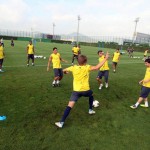03.04.13Annals of Coaching: The Rondo, My Desert Island Drill
 Remember back in the 80s or 90s when it was standard practice to know your three “desert island discs,” the (vinyl) albums you’d take with you if you were going to be stuck on a desert island for a long time? The idea was to ID the music that was not only best but most versatile and timeless. Something that would cover all your bases if you only had a few things to draw on.
Remember back in the 80s or 90s when it was standard practice to know your three “desert island discs,” the (vinyl) albums you’d take with you if you were going to be stuck on a desert island for a long time? The idea was to ID the music that was not only best but most versatile and timeless. Something that would cover all your bases if you only had a few things to draw on.
I spent the weekend in Boston watching my son’s soccer team play in a tournament. One upside to 30 or so hours of youth soccer is that it gives you time to reflect. So on Sunday morning as my son’s team warmed up in a light snow I found myself mulling over my Desert Island Drills. If I had to nominate one “perfect” drill—high quality, versatile, timeless, etc.—what would I choose? I think the “rondo” –aka 4 or 5 or 6 vs 2 keepaway–would be the winner. I feel a little sheepish picking it because it’s clearly the pick of so many others—as Katie Erica and I note in Practice Perfect, Xavi says they basically do rondos every day over in Spain, but watching my son’s Rondo-ing reminded me of a few reasons why the drill is so good and led me to wonder about a surprising twist on rigor.
Benefits of the Rondo
Practices the most important fundamentals: Ok, so this is obvious. The core of the modern game is tiki taka, fast, possession-maintaining one- and two-touch passing. Rondos practice that core element but with constant variety of circumstances.
Practices decision making: Soccer is game that makes players make decisions. So you want them to practice making decisions. Rondos force them to constantly practice fast decision-making, usually by reading where defenders are and want to go. It therefore reinforces the mental as well as physical fundamentals of the game.
Offense and defense: “The great majority of coaches spend the great majority of their time coaching the offensive side of the ball,” Chris Apple (Head coach at the Revolution Empire and University of Rochester) told me. And he’s right. We tend to short kids on how to play defense. But with a little tweaking the rondo can stress the guys in the middle as much as the guys on the outside. And of course you’re practicing it both ways.
Adaptive: One of the keys to a good drill is that it can be adapted. That is, a good practice offers fewer drills but lots of variations within the drill. Rondos can serve that purpose in a thousand ways. If you search Barca and rondo on YouTube you’ll see them playing with 8 players on the outside, with six players on the outside, with one touch, with the ball in the air, etc. You can vary it to only give points for splitting defenders, or for making 10 passes in a row, (or for preventing more than 5 passes or for not getting split). This makes exposing players to new scenarios and preparing them highly efficient. You take a base that they can set up and do efficiently right away and add a minor adaptation. You get fast learning at maximum efficiency.
Last thought: Whenever I see video of the glory clubs (Barca, Man U etc) practicing rondos, they don’t do 4 v 2. More often it seems like it’s 5 or 6 or 8 v 2. So I found myself wondering why. Is there some way that 5 or 6 is more rigorous? Maybe not, maybe they just like to use a gentle version for warm-ups. But maybe so… and here’s a theory on why that might be… because it’s harder for the defenders to get the ball in 5 or 6 v 2, the price of an error goes up. That is, giving the ball away is a serious punishment. When you’re in the middle you work hard and are in there for a long time. As Xavi notes, you really want to avoid it! And this raises the stakes. In 4 v 2 it’s sometimes no big deal to give away the ball because it happens pretty often. That may not always be the strongest incentive. 5, 6 and 8 v 2 also more closely replicates the angles of the game, which are rarely purely geometrical square. Like a good Barca attack rondos with 6 or 8 players on the outside involve little tiny touches and slight shifts and fast movement in a line before—boom!—the cutting pass splits the defense and sends someone clear.
Anyway that could all be wrong. Hopefully some smarter coaches will give us their 2 cents worth. What makes rondos great (or limited?). And what are your desert island drills?

By the way if you don’t know what a rondo looks like, click here:
http://www.youtube.com/watch?v=3RNfaIW5k1g